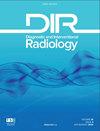Radiomics with artificial intelligence: a practical guide for beginners.
IF 2.1
4区 医学
Q2 Medicine
引用次数: 186
Abstract
Radiomics is a relatively new word for the field of radiology, meaning the extraction of a high number of quantitative features from medical images. Artificial intelligence (AI) is broadly a set of advanced computational algorithms that basically learn the patterns in the data provided to make predictions on unseen data sets. Radiomics can be coupled with AI because of its better capability of handling a massive amount of data compared with the traditional statistical methods. Together, the primary purpose of these fields is to extract and analyze as much and meaningful hidden quantitative data as possible to be used in decision support. Nowadays, both radiomics and AI have been getting attention for their remarkable success in various radiological tasks, which has been met with anxiety by most of the radiologists due to the fear of replacement by intelligent machines. Considering ever-developing advances in computational power and availability of large data sets, the marriage of humans and machines in future clinical practice seems inevitable. Therefore, regardless of their feelings, the radiologists should be familiar with these concepts. Our goal in this paper was three-fold: first, to familiarize radiologists with the radiomics and AI; second, to encourage the radiologists to get involved in these ever-developing fields; and, third, to provide a set of recommendations for good practice in design and assessment of future works.放射组学与人工智能:初学者实用指南。
放射组学是放射学领域的一个相对较新的词汇,意思是从医学图像中提取大量定量特征。人工智能(AI)广义上是一套先进的计算算法,它基本上可以学习所提供数据中的模式,从而对未见过的数据集做出预测。放射组学可以与人工智能相结合,因为与传统的统计方法相比,放射组学处理大量数据的能力更好。总之,这些字段的主要目的是提取和分析尽可能多的有意义的隐藏定量数据,以便在决策支持中使用。如今,放射组学和人工智能都因在各种放射任务中取得的显著成功而备受关注,但由于担心被智能机器取代,大多数放射科医生都感到焦虑。考虑到计算能力的不断发展和大数据集的可用性,人类和机器在未来临床实践中的结合似乎是不可避免的。因此,无论他们的感受如何,放射科医生都应该熟悉这些概念。我们在本文中的目标有三个方面:首先,让放射科医生熟悉放射组学和人工智能;第二,鼓励放射科医生参与这些不断发展的领域;第三,为将来的设计和评估工作提供一套良好的实践建议。
本文章由计算机程序翻译,如有差异,请以英文原文为准。
求助全文
约1分钟内获得全文
求助全文
来源期刊
CiteScore
3.50
自引率
4.80%
发文量
69
审稿时长
6-12 weeks
期刊介绍:
Diagnostic and Interventional Radiology (Diagn Interv Radiol) is the open access, online-only official publication of Turkish Society of Radiology. It is published bimonthly and the journal’s publication language is English.
The journal is a medium for original articles, reviews, pictorial essays, technical notes related to all fields of diagnostic and interventional radiology.

 求助内容:
求助内容: 应助结果提醒方式:
应助结果提醒方式:


